Sigma 17-70mm f/2.8-4.5 Macro DC
The latest lens developed by Sigma for its DC range for cropped sensor cameras (APS-C sized sensors) is this fast standard zoom with close focus capability. With a focal length range of 17-70mm and able to focus down to less than eight inches, we take the UK’s first look at how it performs.
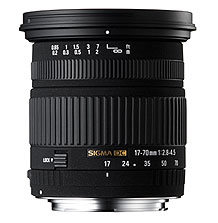 Specification
Specification
- Focal Length 17-70mm
- Construction 15/12 elements/groups
- Angle of view 72.4º-20.2º (SD format 1.7x crop)
- Max Aperture f/2.8-4.5
- Min Aperture f/22-f/32
- Min focus 20cm/7.9inch
- Max magnification 1:2.3
- Filter size 72mm
- Dimensions 79x82.5mm
- Weight 0.455kg
- Mount Sigma, Canon, Nikon, Pentax, Minolta.
- SRP £269.99
Build and Handling
Supplied with a petal shaped hood, the lens is finished in Sigma’s matt black finish and sports a metal mount. There is an AF/MF switch on the left of the barrel before the 35mm zoom ring, which carries a zoom lock to stop the lens extending during transport. I did not use it, as, although nicely torqued, the lens did not seem to creep during either use or transport. The zoom ring has 20mm of raised ribbing and is marked at 17, 24, 35, 50 and 70mm. As you zoom out to the 70mm mark, the lens extends some 40mm on a double trombone. With the extension, a reproduction ratio scale is revealed on the first tube, a nice touch. Whilst not true Macro, only reaching a ratio of 1:2.3, this close focus capability of only 200mm is very useful.
Double trombones are prone to play but there was none evident in this one and, along with the internal focus mechanism, means the front element does not rotate making filter use far easier.
Autofocussing is fairly quiet for a conventional motor and quick enough to cope with most uses, especially those that this type of lens will be put to. Probably helped by the wide aperture, there was virtually no hunting. Switchover to manual is achieved by the switch that frees up the 20mm manual focus ring, half of which has raised rubber ribbing and is marked with a distance scale in both metres and feet. The front element surround steps up to take the 72mm filters and a bayonet fit hood that has a positive click to hold it in place.
Optical Quality
This lens produced surprisingly good results throughout the focal range although as usual, they were best at the shorter lengths. The one exception being where distortion is concerned and that is by far the best at the longer focal length. At 17mm it measured –5.05% (barrel) whereas the longer end returned 0.32%(pincushion), undetectable by eye.
Resolution figures are pleasing, especially once the lens is stopped down by the odd stop or so and even wide open the visual results are encouraging.
Chromatic aberrations are kept well below the single pixel level throughout the aperture range and across the frame, a commendable performance. Combined with good contrast and the digital coating that Sigma now use to reduce incidences of flare and ghosting, neither of which reared their ugly heads, the lens performed well above the standard ‘kit’ lenses in this focal range.
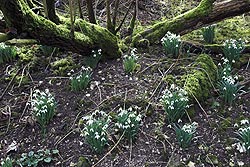 Woodland scene with the lens set at 30mm. By this length, distortion is no longer visible. ISO400, 1/60sec at f/8. |  Backlit snowdrops are a subject that will show any incidence of chromatic aberration up alarmingly but there is no sign in this shot which also shows the lens’s close focus ability. 1/150 at f/10 and ISO100 on 20D with the lens set at 70mm |
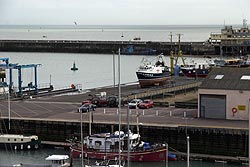 The lens’s focal range is quite handy. 70mm and 1/320sec at f/8, ISO100. |
Click on each comparision photo below to view full size versions
Below is our lens test data. To find out how to use these graphs look at this article: How we test lenses
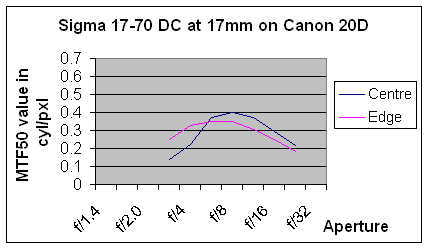
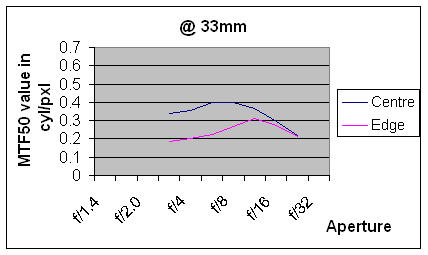
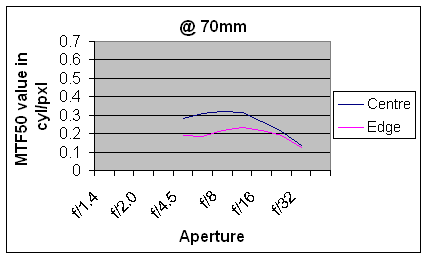
Verdict
In it’s price bracket, this lens can be considered good. It’s one drawback is the distortion at the wide end, but this is one of the easier problems to cure in digital software and being designed purely for digital cameras with cropped sensors will have no effect on film users. The DC/DG coating that Sigma now uses has gone a long way to improving their lens’s contrast and this shows well in this example. The close focus ability of this offering also helps to greatly increase its versatility.
In summary, the positive points of the Sigma 17-70mm f/2.8-4.5 DC Macro are:
![]() Excellent close focus ability
Excellent close focus ability
![]() Good build with no wobbles
Good build with no wobbles
![]() Good resolution figures overall
Good resolution figures overall
The negative points are:
![]() Barrel distortion at the wide end
Barrel distortion at the wide end
![]() AF not as quiet as HSM lenses
AF not as quiet as HSM lenses
Check the latest price of the Sigma 17-70mm f/2.8-4.5 DC Macro here
Test by Ian Andrews www.wildaboutkent.co.uk
Add your message
Please login here or if you've not registered, you can register here. Registering is safe, quick and free.
photodo Stats
428 MTF tests
74 in-depth photodo reviews
100+ users join each day
Help the lens community by reviewing or rating a lens today via our lens search
Latest Lens Reviews
- Chinon 28mm f/2.8 Vintage Lens Review
- Canon EF 70-200mm f/4L IS II USM Lens Review
- Samyang AF 85mm f/1.4 EF Review
- Sigma 70mm f/2.8 DG Macro Art Review
- Samyang AF 24mm f/2.8 FE Review
- Meike 50mm f/1.7 Review
- Tamron 70-210mm f/4 Di VC USD Review
- Lensbaby Burnside 35mm f/2.8 Review
- Asahi Super Takumar 50mm f/1.4 Review
- Asahi Super-Multi-Coated Takumar 135mm f/3.5 Review




